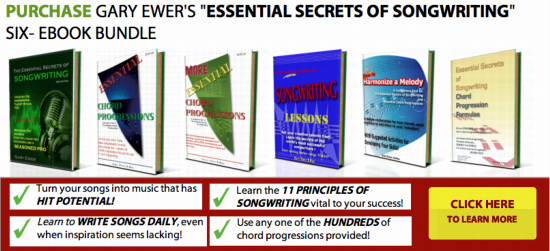Choosing a time signature other than the very common 4/4 can add a touch of uniqueness to your music.
_____________ Download “The Essential Secrets of Songwriting” 6-eBook Bundle, and learn the 11 principles crucial to any songwriter’s success. _____________  It’s natural for songwriters to look for ways to make their music sound unique. One way to create something interesting is to play around with your song’s time signature. The time signature, or meter, is the grouping of beats into strong and weak pulses. If you haven’t given time signatures much thought before, don’t worry — most songwriters can create good music without thinking about this much, since the time signature happens in a kind of automatic way. But I’m encouraging you to give this element of music a bit more thought, because experimenting with meter can give you an interesting way of making your music sound just a little different from other songs. The vast majority of music in the popular genres of pop, rock, country and folk are in 4/4 time. That means that the music is arranged to be in alternating strong and weak pulses. This accounts for probably more than 95% of songs. The next most common arrangement of pulses is some sort of triple meter, where the music is arranged into a pattern of one strong pulse followed by two weak pulses. Some well-known examples: “Norwegian Wood” (The Beatles) and “She’s Always a Woman” (Billy Joel). But with a bit of experimenting you can create something that’s a bit more radical, and can help set your song apart from others. To get a sense of the feel each one creates, listen to the suggested example:
It’s natural for songwriters to look for ways to make their music sound unique. One way to create something interesting is to play around with your song’s time signature. The time signature, or meter, is the grouping of beats into strong and weak pulses. If you haven’t given time signatures much thought before, don’t worry — most songwriters can create good music without thinking about this much, since the time signature happens in a kind of automatic way. But I’m encouraging you to give this element of music a bit more thought, because experimenting with meter can give you an interesting way of making your music sound just a little different from other songs. The vast majority of music in the popular genres of pop, rock, country and folk are in 4/4 time. That means that the music is arranged to be in alternating strong and weak pulses. This accounts for probably more than 95% of songs. The next most common arrangement of pulses is some sort of triple meter, where the music is arranged into a pattern of one strong pulse followed by two weak pulses. Some well-known examples: “Norwegian Wood” (The Beatles) and “She’s Always a Woman” (Billy Joel). But with a bit of experimenting you can create something that’s a bit more radical, and can help set your song apart from others. To get a sense of the feel each one creates, listen to the suggested example:
- 5/8 or 5/4 time. Example: “Everything’s Alright”, from “Jesus Christ Superstar“. Think of 5/8 time as having two main pulses, where one is a little longer than the other. In “Everything’s All Right”, the first beat is longer than the second one (called “3-plus-2”), but you can also try a shorter first beat (“2-plus-3”). Listen to Chicago’s “Mother“, starting at 2’44” of this live version.
- 7/8 or 7/4 time. Example: “Money” (Pink Floyd). When done relatively slowly, it sounds like 7 fairly even beats. But in most cases you’ll hear that beats 1 and 5 sound stronger than the others, giving you what sounds like a 4/4 bar followed immediately by 3/4. You hear this in “All You Need Is Love” (The Beatles), as well as in Peter Gabriel’s “Solsbury Hill“
- Alternating 6/8 and 3/4. Example: “America” (Leonard Bernstein). Both of these time signatures (6/8 and 3/4) have the same number of 8th notes in each bar. The difference is in the way those 8th notes are grouped. In 6/8 they’re combined into 2 groups of 3, while 3/4 has them combined into 3 groups of 2. So switching quickly back in forth, as you hear in “America” generates a considerable amount of energy.
- Complex Time Signatures. Example: “Firth of Fifth” (Genesis). This a a great song to prove that weird time signatures don’t necessarily make a song sound weird. The opening piano solo of this song combines the signatures 2/4, 13/16 and 15/16. It’ll take some practice to get it right in performance, however!
- Changing Time Signatures. Example: “Another Day” (Paul McCartney). There’s no rule that says that once you’ve chosen a time signature you must stick with it for the entire song. You can create a very unique musical experience for your audience by changing it at seemingly random times. There’s a downside to this, though, as it can interfere with the basic groove of your song.
_______________










